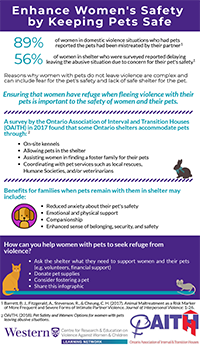Infographics
This collection of Learning Network resources is designed to synthesize and disseminate knowledge on topics related to Gender-Based Violence (GBV). These resources provide foundational GBV knowledge including commonly used language, important gaps and emerging issues, recent research, and important educational tools and resources.
Our Infographics display information in a concise and engaging graphic manner.
Integrating Faith Sensitivity into Gender-Based Violence (GBV) Work: 10 Frontline Practices (2025)
 This new one-page infographic — based on and adapted from the LN Brief Integrating Faith Sensitivity into GBV Work by Dr. Sandra Pertek — outlines 10 evidence-based practices to help service providers integrate faith sensitivity into day-to-day work. Grounded in intersectional, survivor-centered, and trauma-informed approaches, the resource is designed to be both accessible and actionable.
This new one-page infographic — based on and adapted from the LN Brief Integrating Faith Sensitivity into GBV Work by Dr. Sandra Pertek — outlines 10 evidence-based practices to help service providers integrate faith sensitivity into day-to-day work. Grounded in intersectional, survivor-centered, and trauma-informed approaches, the resource is designed to be both accessible and actionable.
Love Bombing (2024)
 This infographic shares what love bombing is, how it may occur, and what can be done to support survivors of love bombing.
This infographic shares what love bombing is, how it may occur, and what can be done to support survivors of love bombing.
Fathers Play a Critical Role! Actions to Promote Gender Equality (2024)
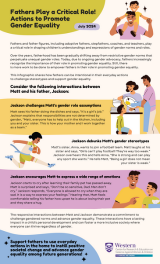 This infographic shares how fathers can be intentional in their everyday actions to challenge stereotypes and support gender equality.
This infographic shares how fathers can be intentional in their everyday actions to challenge stereotypes and support gender equality.
International Students and Emotional Abuse: Campuses Must Offer Support! (2024)
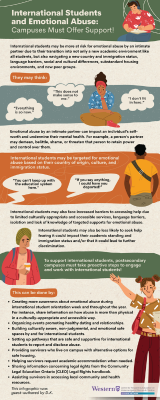 This infographic shares some of the ways international students experience emotional abuse, barriers to accessing help, and how postsecondary campuses can take proactive steps to offer supports.
This infographic shares some of the ways international students experience emotional abuse, barriers to accessing help, and how postsecondary campuses can take proactive steps to offer supports.
10 Ways to Invest in Survivor Expertise (2024)
 In this infographic, we identify everyday actions and structural changes that can be adopted at the organizational level to ethically and equitably include and center survivor expertise.
In this infographic, we identify everyday actions and structural changes that can be adopted at the organizational level to ethically and equitably include and center survivor expertise.
This infographic was made in partnership with the Region of Peel Anti-Human Sex Trafficking Program.
Trauma-Informed Support for Survivors of Female Genital Mutilation/Cutting (2024)
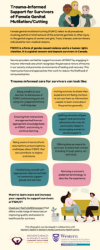 Female genital mutilation/cutting (FGM/C) is a form of gender-based violence and is a human rights violation. It is a global concern and impacts survivors in Canada.
Female genital mutilation/cutting (FGM/C) is a form of gender-based violence and is a human rights violation. It is a global concern and impacts survivors in Canada.
Service providers can better support survivors through trauma-informed care. Find strategies in this infographic developed in collaboration with Women's Health in Women's Hands Community Health Centre.
Experiences of Weight-Based Discrimination and Violence (2023)
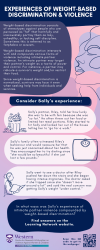 This infographic shares information about what weight-based discrimination is and how it intersects with intimate partner violence through an interactive example.
This infographic shares information about what weight-based discrimination is and how it intersects with intimate partner violence through an interactive example.
Sexting Only With Consent! (2023)
 This infographic shares information about the importance of consent in sexting. It describes what sexting is, the role of consensual sexting, and what sexting looks like in healthy relationships.
This infographic shares information about the importance of consent in sexting. It describes what sexting is, the role of consensual sexting, and what sexting looks like in healthy relationships.
Support Rainbow Seniors! 3 Things for Service Providers to Know (2022)
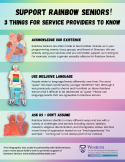 This infographic shares three concrete actions that service providers can take to support Rainbow Seniors who are part of the 2SLGBTQI+ community.
This infographic shares three concrete actions that service providers can take to support Rainbow Seniors who are part of the 2SLGBTQI+ community.
This infographic was made in partnership with leZlie lee kam.
Stronger Together! 3 Reasons for Local Governments & Community Organizations to Collaborate to End GBV (2022)
Not Optional! 4 Building Blocks for Collaboration Between Local Governments & Community Organizations to End GBV (2022)
Context Matters! Gender-Based Violence in Sport (2022)
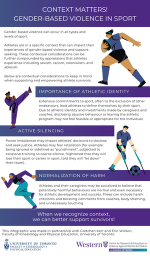 This infographic shares contextual considerations to keep in mind when supporting and empowering athlete survivors of gender-based violence.
This infographic shares contextual considerations to keep in mind when supporting and empowering athlete survivors of gender-based violence.
Coercive Control During Intimate Partner Violence: What About Children? (2022)
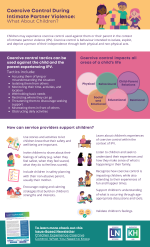 This infographic focuses on how children and parents experience coercive control during intimate partner violence, and what service providers can do to support children.
This infographic focuses on how children and parents experience coercive control during intimate partner violence, and what service providers can do to support children.
Trans Women and Intimate Partner Violence: Fundamentals for Service Providers (2021)
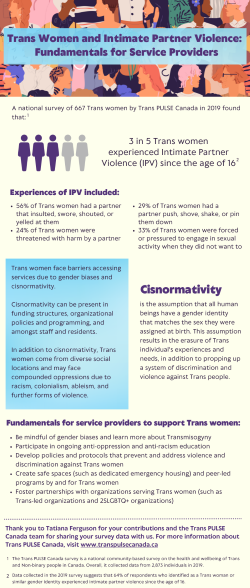 This infographic shares data from a national Trans PULSE Canada survey regarding Trans women's experiences of intimate partner violence.
This infographic shares data from a national Trans PULSE Canada survey regarding Trans women's experiences of intimate partner violence.
It identifies barriers Trans women face in accessing services and offers some fundamentals for service providers to support Trans women.
Intersecting Oppressions Shape Experiences of IPV Faced by Women with Disabilities (2021)
 This infographic shares the necessity of an intersectional approach to intimate partner violence as such an approach helps to ensure that prevention efforts and service delivery meet the needs of survivors.
This infographic shares the necessity of an intersectional approach to intimate partner violence as such an approach helps to ensure that prevention efforts and service delivery meet the needs of survivors.
Sex Only with Consent! (2021)
This infographic shares what consent is and when consent cannot be given.
Economic Abuse: Coercive Control Tactics in Intimate Relationships (2021)
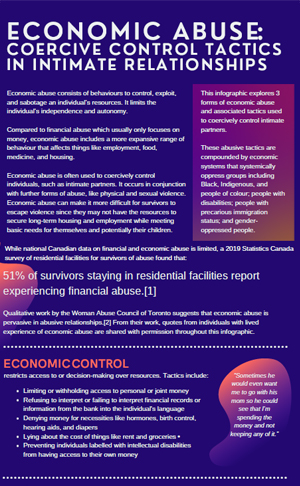 This infographic explores 3 forms of economic abuse and associated tactics used to coercively control intimate partners.
This infographic explores 3 forms of economic abuse and associated tactics used to coercively control intimate partners.
End Violence in Canadian Nursing and Retirement Homes (2021)
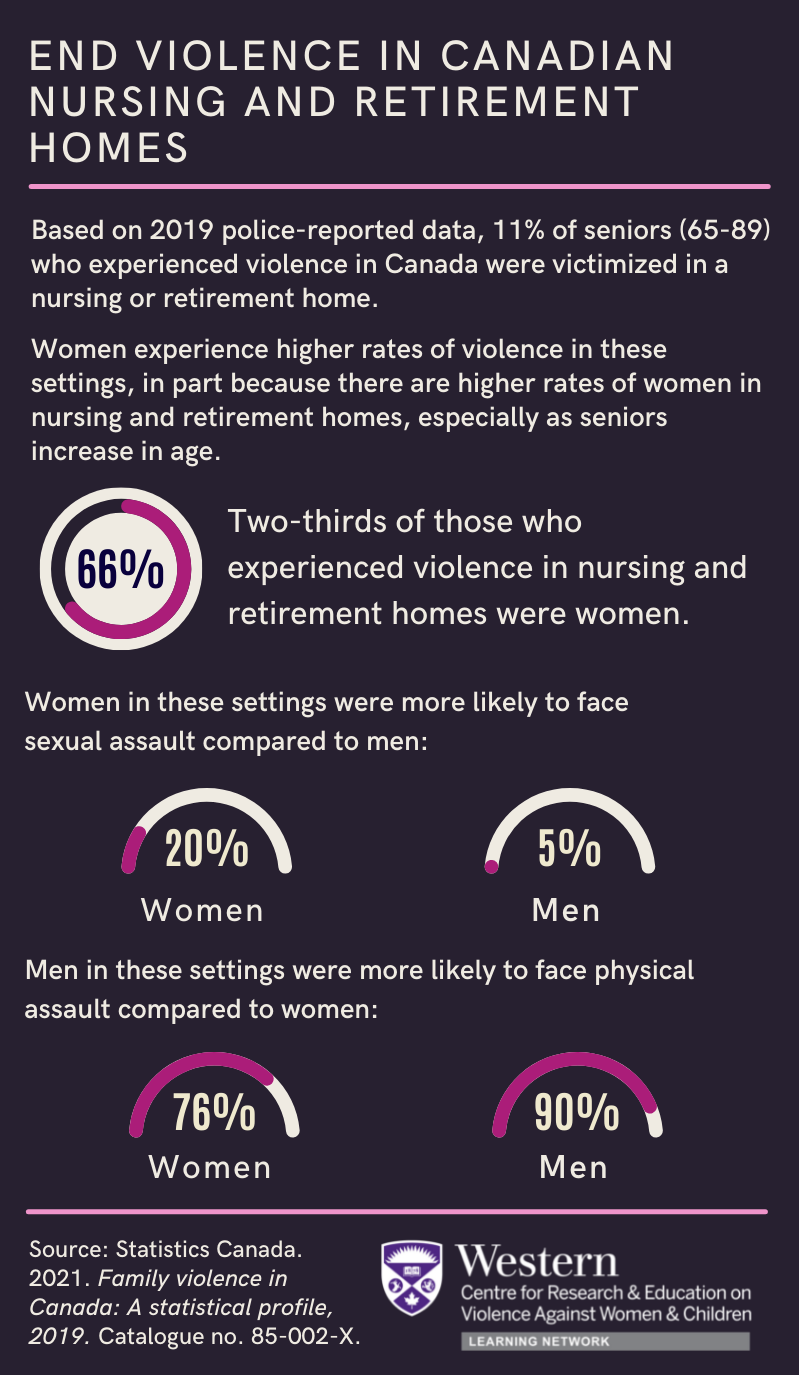 This infographic shares 2019 police-reported data about violence against seniors in nursing and retirement homes.
This infographic shares 2019 police-reported data about violence against seniors in nursing and retirement homes.
Senior Women Face Disproportionate Rates of Family Violence (2021)
 This infographic shares police-reported data on how senior women in Canada are more likely than senior men to experience family violence, particularly spousal violence.
This infographic shares police-reported data on how senior women in Canada are more likely than senior men to experience family violence, particularly spousal violence.
Stress, Interpersonal Violence and COVID-19 (2020)
 COVID-19 has changed many aspects of our lives, including our mental health. Pandemic-related stress may have an even greater impact on people who are already coping with trauma such as intimate partner violence, sexual violence or child maltreatment
COVID-19 has changed many aspects of our lives, including our mental health. Pandemic-related stress may have an even greater impact on people who are already coping with trauma such as intimate partner violence, sexual violence or child maltreatment
7 Protective Factors that Promote Children's Resilience (2020)

This infographic provides a brief overview of 7 promising protective factors that have been shown to promote children’s resilience following exposure to intimate partner violence.
Sexual Violence and COVID-19 (2020)
Intimate Partner Violence in a Pandemic: COVID-19-Related Controlling Behaviours (2020)
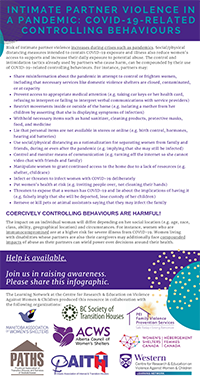 This infographic shares how the control and intimidation tactics already used by partners who cause harm, can be compounded by their use of COVID-19-related controlling behaviours.
This infographic shares how the control and intimidation tactics already used by partners who cause harm, can be compounded by their use of COVID-19-related controlling behaviours.
3 Considerations for Supporting Women Experiencing Intimate Partner Violence During the COVID-19 Pandemic (2020)
 This infographic shares three considerations when supporting women experiencing intimate partner violence during the COVID-19 pandemic.
This infographic shares three considerations when supporting women experiencing intimate partner violence during the COVID-19 pandemic.
Gender Earnings Gap Among Post-Secondary Graduates (2020)
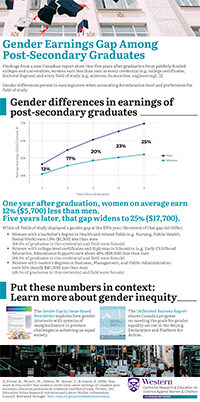
This infographic shows the earning disparities between men and women 5 years after post-secondary graduation.
View Infographic
What You Need To Know About Non-Consensual Sexual Deepfakes (2019)
This inforgraphic focuses on the non-consensual use of adults' images and videos in the production and distribution of sexual deepfakes.
University Student Voices on Sexual Violence - Results from an Ontario-Wide Survey (2019)
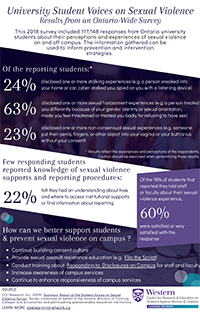
Student Voices on Sexual Violence: Results from an Ontario-wide Survey (2019)
University Student Voices on Sexual Violence - Results from an Ontario-Wide Survey
This infographic summarizes the results from a 2018 study on the responses from Ontario university students about their perceptions and experiences of sexual violence on and off campus.
College Student Voices on Sexual Violence - Results from an Ontario-Wide Survey (2019)
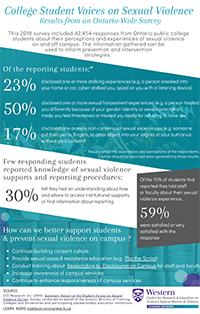
Student Voices on Sexual Violence: Results from an Ontario-wide Survey (2019)
College Student Voices on Sexual Violence - Results from an Ontario-Wide Survey
This infographic summarizes the results from a 2018 study on the responses from Ontario university students about their perceptions and experiences of sexual violence on and off campus.
View Infographic
Traumatic Brain Injury (TBI) and Intimate Partner Violence (IPV): Supporting Survivors in Shelters (2018)
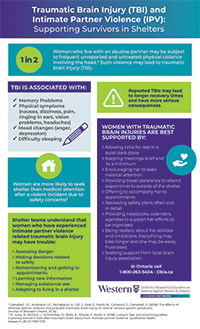
This infographic shows how women who face IPV are at increased risk for violence, which can lead to traumatic brain injury (TBI). It shares how TBI affects women and how survivors of IPV experiencing TBI may be supported.
View Infographic
10 reasons why housing issues in Canada put youth at risk (2018)
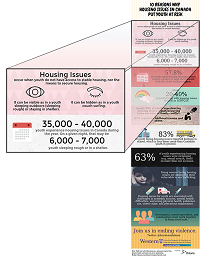
This infographic lists 10 reasons why youth in Canada are put at risk due to housing issues.
View Infographic
Barriers to Reporting or Disclosing Violence and Seeking Help (2018)
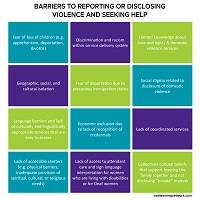
Intimate Partner Violence Against Immigrant and Refugee Women
Barriers to Reporting or Disclosing Violence and Seeking Help
This infographic provides examples of barriers that immigrant or refugee women may encounter that prevent them from getting appropriate help or from disclosing violence.
View Infographic
Factors that Contribute to Risks and Vulnerabilities associated with IPV in Immigrant and Refugee Communities (2018)
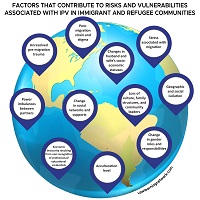
Intimate Partner Violence Against Immigrant and Refugee Women
Factors that Contribute to Risks and Vulnerabilities associated with IPV in Immigrant and Refugee Communities
This infographic shows some global factors that contribute to the risks and vulnerabilites that are associated with intimate partner violence in immigrant and refugee communities.
View Infographic
Preventing Violence in Immigrant and Refugee Communities (2018)
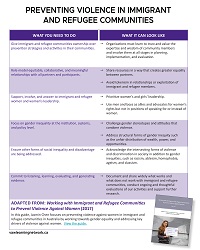
Intimate Partner Violence Against Immigrant and Refugee Women
Preventing Violence in Immigrant and Refugee Communities
This infographic presents 6 ways to prevent violence in immigrant and refugee communities. It also provides examples of practical ways that can help address this issue.
View Infographic
Structural Violence Impacting Marginalized Women (2018)
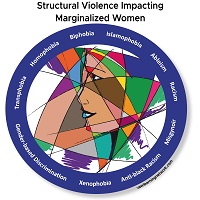
Intimate Partner Violence Against Immigrant and Refugee Women
Structural Violence Impacting Marginalized Women
This infographic lists some of the forms of structural violence that often compound the experiences of marginalized women.
View Infographic
Enhance Women's Safety by Keeping Pets Safe (2017)
Enhancing Women's Safety by Keeping Pets Safe
View Infographic
Sexual Consent is Essential (2017)

Sexual Consent is Essential
This infographic provides examples of what consent sounds like and the conditions that are necessary to obtain consent.
View Infographic
IPV Perpetration & Child Maltreatment: Shared Risk Factors (2016)
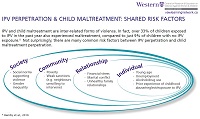 |
Boys' Victimization & Adult IPV Perpetration: Opportunities for Prevention Across the Life Course (2016) IPV Perpetration & Child Maltreatment: Shared Risk Factors This inforgraphic addresses the shared risk factors between IPV perpetration and child maltreatment. View Infographic |
Associated Consequences of Family Violence Across the Life Course (2016)
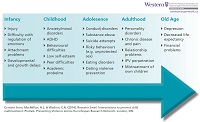 |
Boys Victimization & Adult IPV Perpertration: Opportunities for Prevention Across the Life Course (2016) Associated Consequences of Family Violence Across the Life Course
|
Theoretical Frameworks for the Intergenerational Transmission of Violence (2016)
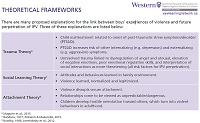 |
Boys Victimization & Adult IPV Perpertration: Opportunities for Prevention Across the Life Course Theoretical Frameworks for the Intergenerational Transmission of Violence This infographic shows the three theoretical frameworks (trauma theory, social learning theory, attachment theory) that explain the link between boys' experiences of violence and future perpetration of IPV.
|
Considerations for Practice in Preventing Violence Across the Life Course (2016)
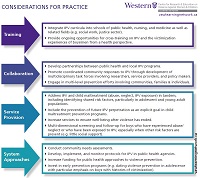 |
Boys Victimization & Adult IPV Perpertration: Opportunities for Prevention Across the Life Course This infographic provdes training, collaboration, services provision and system approaches information that can be implemented into practice to address IPV and the victimization of boys/men.
|
Common Intersections of Sexual and Physical Violence (2016)
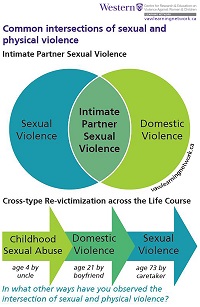
Intimate Partner Sexual Violence
Common Intersections of Sexual and Physical Violence
This infographic shows that intimate partner sexual violence exists in the intersection between sexual violence and domestic violence, and also shows how revictimization occurs across the life course.
View Infographic
Inclusive Language around Intimate Partner Sexual Violence (2016)
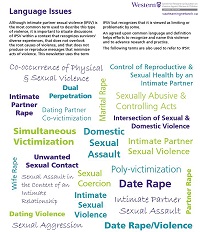
Intimate Partner Sexual Violence
Inclusive Language around Intimate Partner Sexual Violence
This infographic shows the various terms that are used to describe intimate partner sexual violence.
View Infographic
Intimate Partner Sexual Violence Power and Control Wheel (2016)
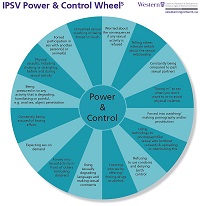
Intimate Partner Sexual Violence
Intimate Partner Sexual Violence Power and Control Wheel
This infographic shows the power and control wheel of intimate partner sexual violence, it includes multiple examples of how IPSV can exist.
View Infographic
Factors Impacting Understandings of Intimate Partner Sexual Violence (2016)

Intimate Partner Sexual Violence
Factors Impacting Understandings of Intimate Partner Sexual Violence
This infographic shows our current understanding of IPSV, it acknowledges its complexities, the multiple facets it exists in and how it is understood.
View Infographic
Intimate Partner Sexual Violence at the Intersections: Examples of Lived Experience (2016)
 Intimate Partner Sexual Violence
Intimate Partner Sexual ViolenceIntimate Partner Sexual Violence at the Intersections: Examples of Lived Experience
This infographic provides examples of women who are likely to face intimate partner sexual violence.
View Infographic
Understanding Rape Culture (2016)
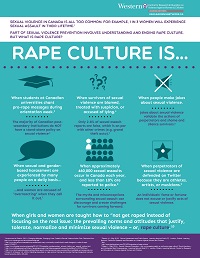
Understanding Rape Culture
This infographic shows the different ways in which rape culture is perpetrated in the Canadian context.
View Infographic
Human Trafficking
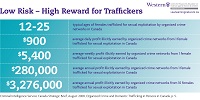 |
Low Risk - High Reward for Traffickers This infographic shows the profit illicitly earned by traffickers for one female for the average day, week, and year.
|
Actions you can take if you are being sexually harassed (2016)
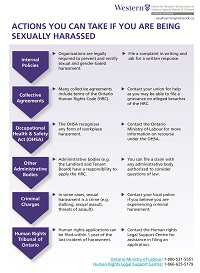
Sexual & Gender-Based Harassment
Actions you can take if you are being sexually harassed
This infographic provides information on actions that victims of sexual harassment can take in receiving support for sexual and gender-based harassment.
View Infographic
Barriers to reporting sexual harassment (2016)
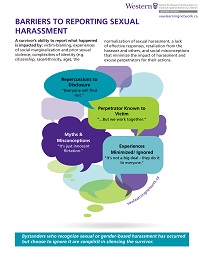
Sexual & Gender-Based Harassment
Barriers to reporting sexual harassment
This infographic explains some of the barriers that exist for victims to report experiences of sexual violence.
View Infographic
Places where sexual harassment occurs and its potential impacts (2016)
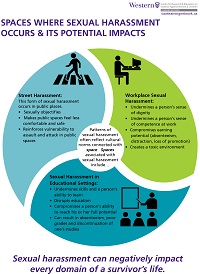
Sexual & Gender-Based Harassment
Places where sexual harassment occurs and its potential impacts
This infographic addresses three spaces where sexual harassment can take place: street harassment, workplace sexual harassment, and sexual harassment in educational settings. It also lists potential impacts of sexual harassment in each of the settings.
View Infographic
Sexual Harassment - What is a myth and what is reality? (2016)
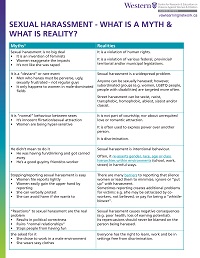
Sexual & Gender-Based Harassment
Sexual Harassment - What is a myth and what is reality?
This infographic distinguishes commonly held myths from the realities of sexual harassment.
View Infographic
Tracing the Roots of Femicide (2015)
|
|
Femicide (2015)
|
Actions to End Femicide (2015)
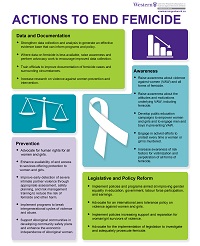
Femicide (2015)
Actions to End Femicide
This infographic emerged from the Issue-Based Newsletter 14: Femicide.
Ideas for Bringing Intersectionality into Practice (2015)
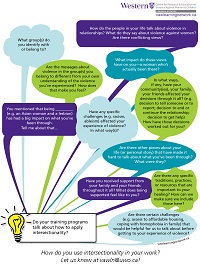
Intersectionality
Ideas for Bringing Intersectionality into Practice
This infographic provides a series of questions that can be incorporated into training programs to apply an intersectionalist approach.
View Infographic
Experiences of gender-based violence are shaped by the intersection of various aspects of identity (2015)
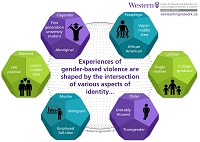 |
Intersectionality Experiences of gender-based violence are shaped by the intersection of various aspects of identity This infographic shows that various aspects of identity can co-exist to shape the experience of gender-based violence. View Infographic |
Questions to consider when working intersectionally (2015)

Intersectionality
Questions to consider when working intersectionally
This infographic provides contextual questions that can be asked when working with an intersectional approach.
View Infographic
Intersectionality Wheel (2015)
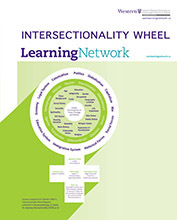
Intersectionality
Intersectionality Wheel
This infographic provides examples of unique circumstances, aspects of identity, types of discrimination impacting identity, a larger structural forces that can be used to inform an intersectional approach. It also lists statistics pertaining to various intersectionalities that exist.
View Infographic
Children's Unique Circumstances of Power, Privilege and Identity (2015)
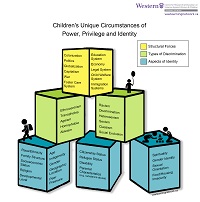
Intersectionality
Children's Unique Circumstances of Power, Privilege and Identity
This infographic lists some of the factors creating unique social circumstances experienced by children, including structural forces, types of discrimination, and aspects of identity.
View Infographic
Barriers to Services for LGBT Survivors and Abusive Partners (2015)
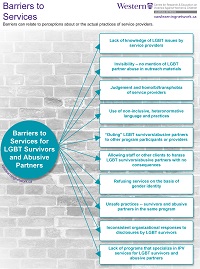
Intimate Partner Violence In Rainbow Communities
Barriers to Services for LGBT Survivors and Abusive Partners
This infographic lists some of the barriers that exist and that LGBT survivors and abusive partners face when trying to access services and help.
View Infographic
Competencies to Reduce Barriers for LGBT Survivors of Intimate Partner Violence (2015)
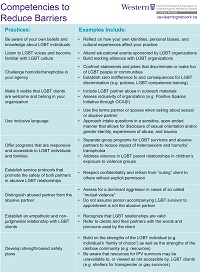
Competencies to Reduce Barriers for LGBT Survivors of Intimate Partner Violence
This infographic lists practices that service providers can incorporate to address the service barriers faced by LGBT individuals, it also provides examples of what these practices can entail.
View Infographic
Experiences of Intimate Partner Violence in Rainbow Communities (2015)

Intimate Partner Violence In Rainbow Communities
Experiences of Intimate Partner Violence in Rainbow Communities
This infographic provides information about the experiences of intimate partner violence survivors, which also include LGBT survivors. It also provides tailored information about various forms of abuse that LGBT survivors face.
View Infographic
Intimate Partner Violence in LGBT Relationships (2015)
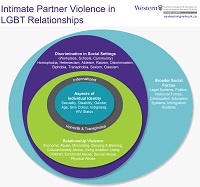
Intimate Partner Violence In Rainbow Communities
Intimate Partner Violence in LGBT Relationships
This infographic shows the multiple, compounding dimensions (including individual and social factors) that impact how LGBT people experience intimate partner violence.
View Infographic
Why is Gender Equality Important (2014)
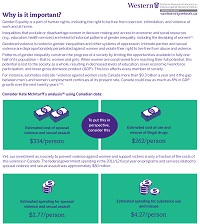 Gender Equality
Gender EqualityWhy is Gender Equality Important
This infographic explains why gender equality is an important measure and why it is important to consider. This means addressing gendered violence, which is rooted in gendered inequalities.
View Infographic
How is Gender Equality Measured? (2014)
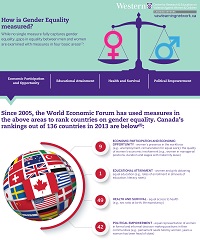
Gender Equality
How is Gender Equality Measured?
This infographic explains how gender equality is measured by the World Economic Forum in terms of economic participation and opportunity, educational attainment, health and survival, and political empowerment.
View Infographic
A Gap Continues to Exist in Women's Political Participation (2014)
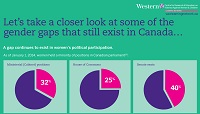 |
Gender Equality A Gap Continues to Exist in Women's Political Participation This inforgraphic shows the gender gaps that exist in women's political participation by looking at the ministerial (cabinet), House of Commons, and Senate seats they hold. View Infographic |
Health & Well-being of Canadian Women (2014)
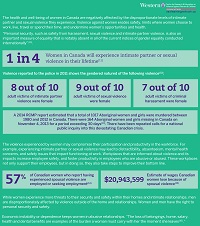 Gender Equality
Gender EqualityHealth & Well-being of Canadian Women
This infographic shows how women are disproportionately affected by intimate partner violence and sexual violence, which affects their participation and productivity in the workforce.
Economic Instability or Dependence Keeping Women in Abusive Relationships (2014)
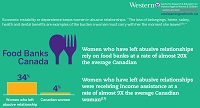 |
Gender Equality Economic Instability or Dependence Keeping Women in Abusive Relationships This infographic shows how leaving an abusive relationship can be economically budensome for women. Survivors escaping violence are more likely to rely on food banks and receive income assistance. View Infographic |
Women's Economic Well-being Continues to Lag Behind Male Peers (2014)
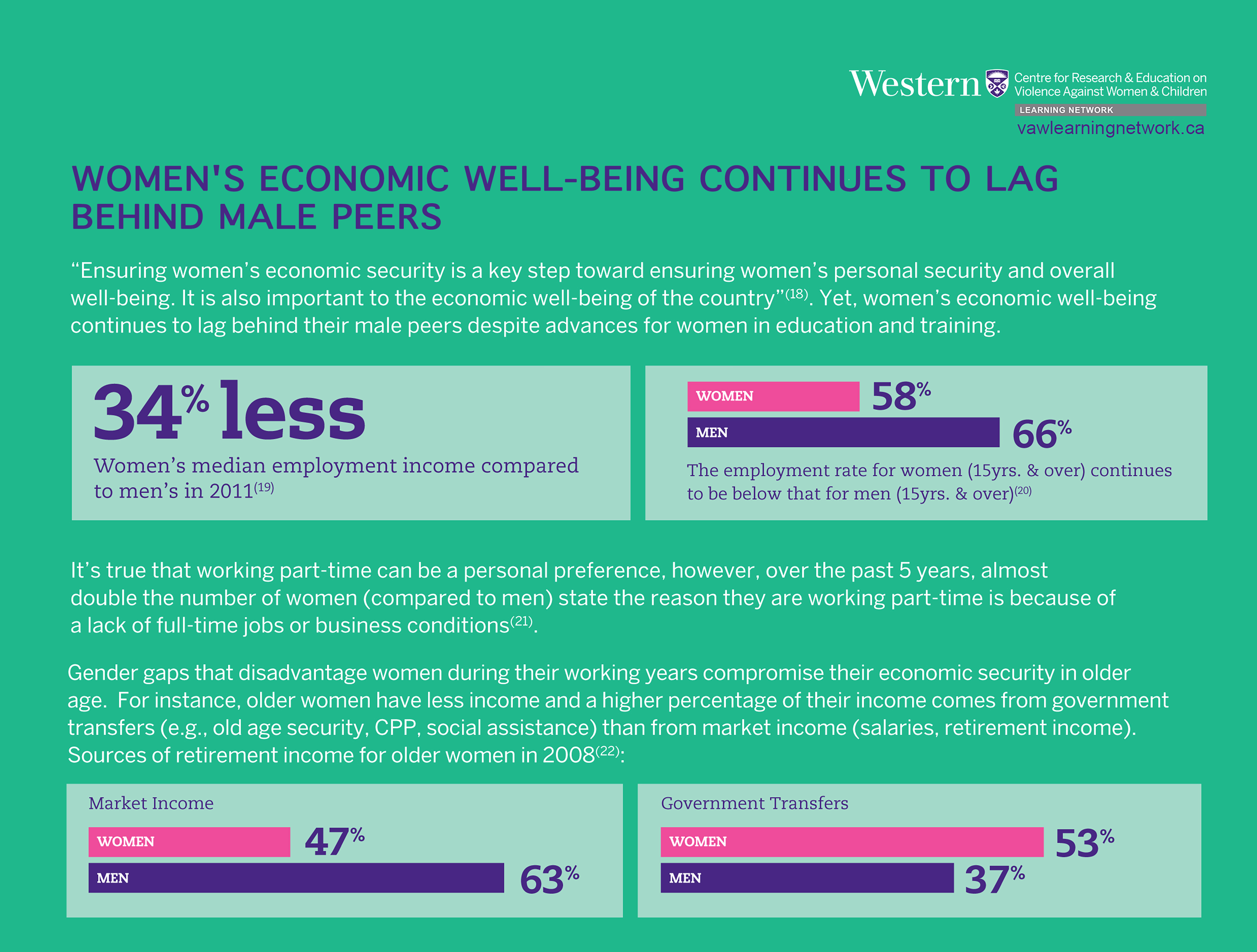 |
Gender Equality Women's Economic Well-being Continues to Lag Behind Male Peers This infographic shows how women's economic well-being continue to lag behind male peers despite advances for women in education and training. View Infographic |
Engaging Men & Boys to End Violence Against Women (2013)

Men's Attitudes and Behaviours Toward Violence Against Women (Infographic created by White Ribbon)
This infographic shares the results from a 2012 study conducted with 1,064 men over 18 in Ontario about their attitudes and behaviours with regard to violence against women.View Infographic
Violence Against Women Living with Disabilities in Canada (2013)
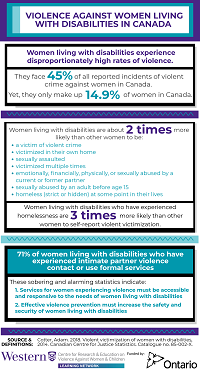 Violence Against Women with DisAbilities and Deaf Women
Violence Against Women with DisAbilities and Deaf WomenViolence Against Women Living with Disabilities in Canada
This infographic shows statistics related to the disproportionate rates of violence women with disabilities experience.
View Infographic
Violence Against Women with disAbilities and Deaf Women (2013)
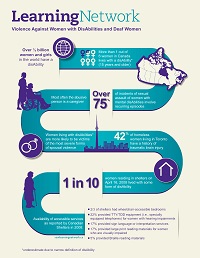
Violence Against Women with DisAbilities and Deaf Women
Violence Against Women with disAbilities and Deaf Women
This infographic shows facts related to the prevalence of violence that women with disabilities face, as well as the rate of services that are available to them.
View Infographic
Violence Against Young Women (2013)

Violence Against Young Women
This infographic presents statistics on violence against women in secondary school, college, and university. It also compares rates of violence against women 15-34 to the rates experienced by older women.
View Infographic
Few Sexual Assaults Lead to Court Convictions (2012)
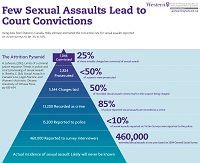
Few Sexual Assaults Lead to Court Convictions
Using data from Statistics Canada, this infographic compares the rates of reported sexual assaults to the percentage of cases that result in court conviction.
View Infographic
All our resources are open-access and can be shared (e.g., linked, downloaded and sent) or cited with credit. If you would like to adapt and/or edit, translate, or embed/upload our content on your website/training materials (e.g., Webinar video), please email us at gbvln@uwo.ca so that we can work together to do so.

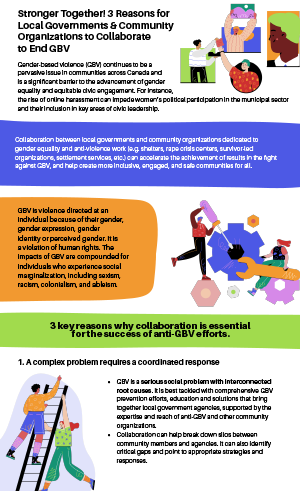 View infographic.
View infographic.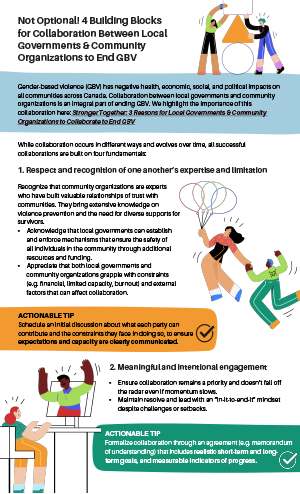 View infographic.
View infographic.


